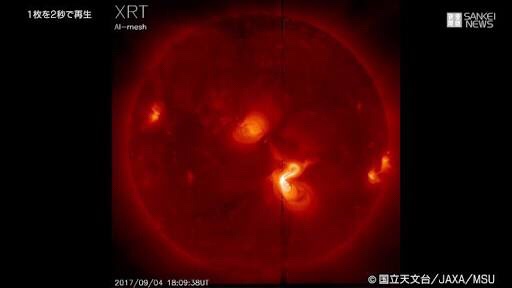
名古屋大学:太阳耀斑预测的新方法:产生条件的阐明
名古屋大学:
名古屋大学等团队于31日在美国科学杂志《科学》上宣布。
阐明太阳耀斑的产生条件:
太阳耀斑影响社会生活,例如停电和通讯故障。
我们已经弄清了在太阳表面发生爆炸“太阳耀斑”的条件,并开发了一种准确预测巨耀斑的位置和规模的方法。
使用此方法分析的10年数据:
使用此方法分析最近10年的数据后,
事实证明,在9场耀斑中,有7场被捕。
预期将提高预测耀斑的“空间天气预报”的准确性。
名古屋大学草野教授:(地球和地球环境物理学)
他说:“这是世界上罕见的突发事件预测的第一种方法,您可以在影响社会之前采取行动。”
联合沟通
https://this.kiji.is/661629804554814561
A physics-based method that can predict imminent large solar flares Predicting large solar flares
The sudden release of magnetic energy on the Sun drives powerful solar flares, which are difficult to predict.
Kusano et al.
derived physics-based thresholds for the onset of large solar flares and show how they can be predicted from routine solar observations (see the Perspective by Veronig).
They tested their method using observations of the Sun from 2008 to 2019.
In most cases, the method
correctly identifies which regions will produce large flares within the next 20 hours, although there are some false positives and false negatives.
The method also provides the exact location where each flare will begin and limits on how powerful it will be.
Accurate predictions of solar flares could improve forecasts of space weather conditions around Earth.
Science, this issue p. 587; see also p. 504
Abstract
Solar flares
are highly energetic events in the Sun’s corona that affect Earth’s space weather.
The mechanism
that drives the onset of solar flares is unknown, hampering efforts to forecast them, which mostly rely on empirical methods.
We present the κ-scheme,
a physics-based model to predict large solar flares through a critical condition of magnetohydrodynamic instability, triggered by magnetic reconnection.
Analysis of the largest (X-class) flares from 2008 to 2019 (during solar cycle 24)
shows that the κ-scheme predicts most imminent large solar flares, with a small number of exceptions for confined flares.
We conclude that
magnetic twist flux density, close to a magnetic polarity inversion line on the solar surface, determines when and where solar flares may occur and how large they can be.
https://www.sciencemag.org/about/science-licenses-journal-article-reuse
Science